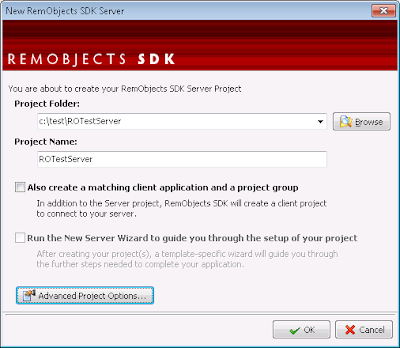With RemObjects (RO) it is very easy to make multi tier applications. For example, you can create one or more RO services (as middle tier) to centralize your main business logic. And with the next SMS update, it is very easy to create nice looking mobile and web front ends (presentation tier) for these remote services!
In this blog, I will try to explain the basis steps to create a RemObjects service. And in the next blog I will explain how to use this RO service in (then updated) Smart Mobile Studio.
Under the hood
Under the hood, the SMS RO integration is actually a typed wrapper around "RemObjects for Javascript" (SMS generates javascript (JS) code after all :) ), and not a complete new implementation. This way, the high RO quality is maintained and all RO features are supported. Also future updates of "RO for JS" can be applied. However, SMS cannot apply smart linking and obfuscation to this external JS code.Basic RemObjects service
First, we will create a very basic RemObjects service in Delphi, using the nice and easy RO wizard:
We choose for "VCL Standalone", because this is the easiest to start with (but if you plan to create a Windows service (for Intranet deployment), I can recommend to use the "Combo Service/Standalone" option). The first page of the RO wizard will be shown:
We choose a project name and folder, and we click on the "Advanced Project Options" for some more settings:
Here you can name the first "RO service" within the "RO library" (normally you will create a number of services, e.g. an OrderService for all order functions, and one library per Windows service). Most important is the HTTP "Server class" (in this case based on Indy, but you can choose other implementations), because this is the only option supported by "RO for JS" to communicate with the server (a browser cannot use plain TCP or Windows messages, however I already made a websocket server class). Next, we can choose between JSON and Binary message format. JSON is supported by all browsers, but binary is not fully supported by Internet Explorer (IE), so we choose for JSON to be on the safe side.
When we finish the wizard, RO will generate a server project for us:
The first thing we do is setting the "SendCrossOriginHeader" to true! This is needed, because our Smart app will run standalone and seperate from the http server. However modern web clients do not allow to call other foreign web servers (for safety reasons). There are other ways to solve this, but for internal use this single setting is the easiest :).
The next step is less obvious for first time RO users: we start the seperate "RemObjects Service Builder" tool (via Delphi -> RemObjects SDK -> Edit service library). The RO wizard has created our BasicService with default 2 functions: "Sum" and "GetServerTime":
We can add more functions, structures, arrays, etc but we will leave this for now. We just close this tool and compile our server project in Delphi. Every time we create a new RO service within the RO Service Builder tool, the RO integration in Delphi will ask once at the next compile to create a implementation unit for the defined service:
function Sum(const A: Integer; const B: Integer): Integer;
function GetServerTime: DateTime;
We will implement the simple :) functionality as follows:
function TBasicService.Sum(const A: Integer; const B: Integer): Integer;
begin
Result := A + B;
end;
function TBasicService.GetServerTime: DateTime;
begin
Result := Now;
end;
This is all we have to do for our first RemObjects service, easy isn't it? :)
In the next blog post we will create a Smart client to use this remote service.






Geen opmerkingen:
Een reactie posten